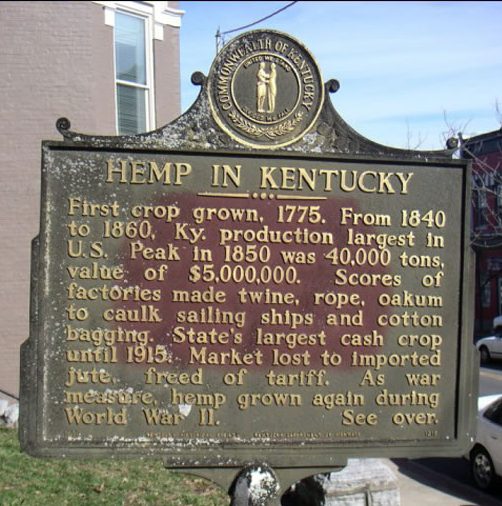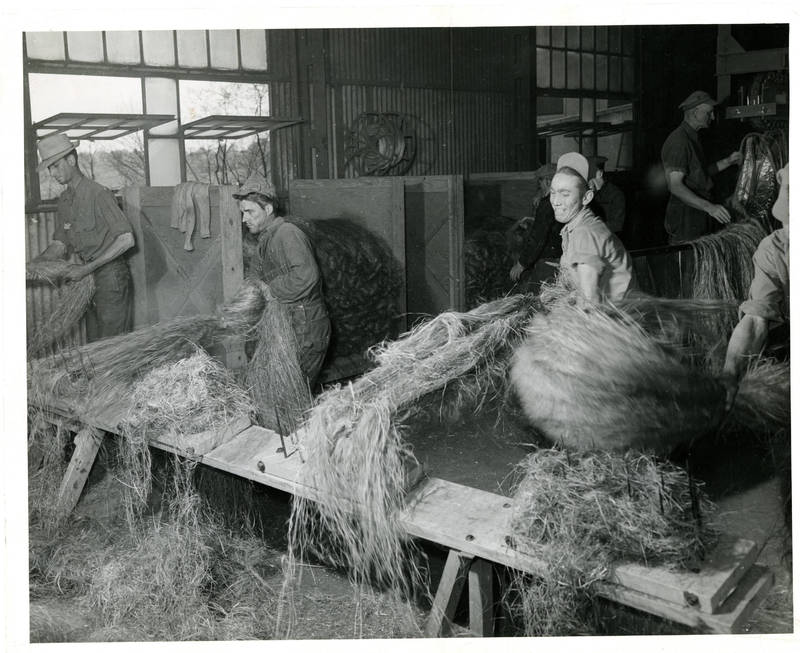Industrial hemp is being promoted as a wonder crop to help replace tobacco and coal in our economy, as well as provide fiber for clothing, organic matter for biofuels, and for the healing properties of CBD. Fears of the hallucinogenic properties of the hemp plant have been used both historically and currently to outlaw its growth in the U.S. (see the Marihuana Tax Act of 1937, for example). Risk assessments for hemp today typically cite concerns over its economic viability as a crop, the safety and effectiveness of CBD to treat a variety of ailments, and overall lack of quality and pricing standards. Worker safety in processing hemp is not a popular area of concern today, and much of the process is now mechanized.

Hemp production was extremely important to Kentucky for most of its history. As explained by the historical marker* pictured below, peak production was achieved in the decades before the Civil War, with 40,000 tons of hemp produced. The bluegrass region was the most productive area for hemp, and “it is not a coincidence that these counties also held the state’s largest slave populations. Hemp, like tobacco and cotton, was a labor-intensive crop… Historian James Hopkins writes, “Without hemp, slavery might have not flourished in Kentucky, since other agricultural products of the state were not conducive to the extensive use of bondsmen. On the hemp farm and in the hemp factories the need for laborers was filled to a large extent by the use of Negro slaves” (Tim Talbott in https://explorekyhistory.ky.gov/items/show/108). *Seven of Kentucky’s more than 2400 historical markers deal with hemp.

The reality is that working in hemp is hard physical work that is often dangerous, from cutting, drying, and transporting it from the fields to breaking the woody stems, and combing out the fibers using a hackle, or coarse comb. The hackling process was especially dangerous, because the air becomes filled with dust and particulates from the repeated flailing, beating, and scraping of the hemp fibers. For more information on hemp processing, see also the story behind Fayette County’s marker: https://explorekyhistory.ky.gov/items/show/718 .

This photograph from the 1920s, while not taken at the penitentiary, gives a good representation of the hackling process, the main labor engaged in by prisoners at the Kentucky State Penitentiary in the 1860s.
Hemp processing was one of many industries at the Kentucky State Penitentiary for which inmate labor was used. In the 1860s, a keeper was elected by the General Assembly, charged a yearly rental fee, and was expected to provide for the needs of the prisoners, hire guards and other personnel, and keep up the buildings and grounds. He was allowed to employ inmate labor and keep the profits (Crawford, 19). The governor appointed three inspectors to provide outside oversight. In August 1863, these inspectors reported that much-needed improvements to the prison had been made, with the exception of the hemp house…”the inhaling of dust and minute portions of the fibre, inducing disease of the lungs…it is the testimony of physicians who at various times have attended the prison, that the cases of Pneumonia occurring in the hemp department of the institution, were of the most alarming and fatal character, the greater proportion of them being from the hackling room in the third story ” (Mills, Hayes, and Garrard, KYR-0001-030-0005)
Dr. William Sneed, the attending physician, found that “..many of the cases were rapidly fatal, some of them lasting not over thirty six hours from their commencement” (ibid.) .
Things were so bad that three amputations were reported at the Kentucky Penitentiary Hospital from Dec 1, 1857-Feb 28, 1859, inclusive: “These were cases in which the convicts cut off their own hands to keep from working at the bagging loom and spinning hemp” (Sneed, 567).
Read more about the penitentiary and its issues, including hemp processing, at
http://discovery.civilwargovernors.org/document/KYR-0001-030-0005 ,
http://discovery.civilwargovernors.org/document/KYR-0001-030-0002 ,
and
http://discovery.civilwargovernors.org/document/KYR-0001-004-3432
For further reading:
Crawford, Robert Gunn. 1955. A History of the Kentucky Penitentiary System, 1865-1937. Dissertation, University of Kentucky.
Sneed, William C. 1860. A Report on the History and Mode of Management of the Kentucky Penitentiary from Its Origin, in 1798, to March 1, 1860. Frankfort, Ky.: Senate of Kentucky.
